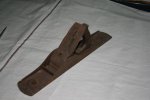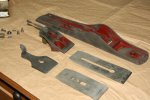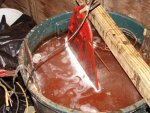Carol Reed
In Memoriam
- Messages
- 5,532
- Location
- Coolidge, AZ
OK, guys and gals, I drug home some serious rust over the weekend. Pictures in a bit - different post.
Obviously I will need to do some serious de-rusting. Been reading about electrolysis. So generally speaking, an anode of iron, water, a plastic container, a battery charger, washing soap, and a few clips. Negative to the part being cleaned, positive to the anode.
But the devil is always in the details. So here are some questions.
1. There can be no physical contact between the part and the anode. If there is we have a welding process. Yes? There is an optimal distance between the 2, the most efficient being ~4'. Yes? A meshed plastic barrier is not a bad idea, but perhaps a good one?
2. The part has to be suspended in the solution, or can it be submersed and touching the plastic container?
3. Is distilled water necessary or can tap water be used if is not unduly high in minerals?
4. Lower voltage and higher amperage ought to be the settings. Yes?
5. Is TSP the same as washing soda?
6. How often do you remove the part, brush off the gunk to see when it is 'done'? Is overnight too long?
7. What do you put on the part immediately after cleaning and before painting and/or waxing to keep the thing from rusting again? Preferably a spray on product. I want to have a paint-able surface without having to remove something else later, if possible. I have low coastal fog to deal with.
8. Does the container have to be a bucket? I was thinking of a plastic concrete mixing tub (HF $7 and needed later for its intended purpose), a piece of rebar down each long side connected together, a plastic mesh barrier between the rebar and the part, and a few concrete chunks to rest the part on. Some of them are rather large, like a table saw table. What do you think?
9. What is the recipe? How much washing soda to how much water?
10. One item has badly corroded aluminum parts, to the point of pitting. How does one clean these up?
Thanks, folks.
Obviously I will need to do some serious de-rusting. Been reading about electrolysis. So generally speaking, an anode of iron, water, a plastic container, a battery charger, washing soap, and a few clips. Negative to the part being cleaned, positive to the anode.
But the devil is always in the details. So here are some questions.
1. There can be no physical contact between the part and the anode. If there is we have a welding process. Yes? There is an optimal distance between the 2, the most efficient being ~4'. Yes? A meshed plastic barrier is not a bad idea, but perhaps a good one?
2. The part has to be suspended in the solution, or can it be submersed and touching the plastic container?
3. Is distilled water necessary or can tap water be used if is not unduly high in minerals?
4. Lower voltage and higher amperage ought to be the settings. Yes?
5. Is TSP the same as washing soda?
6. How often do you remove the part, brush off the gunk to see when it is 'done'? Is overnight too long?
7. What do you put on the part immediately after cleaning and before painting and/or waxing to keep the thing from rusting again? Preferably a spray on product. I want to have a paint-able surface without having to remove something else later, if possible. I have low coastal fog to deal with.
8. Does the container have to be a bucket? I was thinking of a plastic concrete mixing tub (HF $7 and needed later for its intended purpose), a piece of rebar down each long side connected together, a plastic mesh barrier between the rebar and the part, and a few concrete chunks to rest the part on. Some of them are rather large, like a table saw table. What do you think?
9. What is the recipe? How much washing soda to how much water?
10. One item has badly corroded aluminum parts, to the point of pitting. How does one clean these up?
Thanks, folks.




